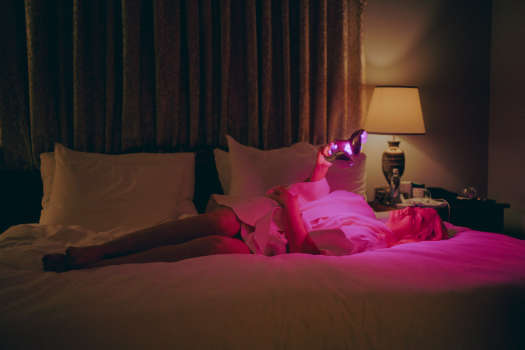Filmed in high-contrast black and white that lends itself well to the glamour and sophistication of the imposing home the film almost entirely takes place in, Mickey Keating's visually striking Darling is obviously inspired by classic "isolated woman goes mad" horror, like the Polanski classic Repulsion or experimental feminist surrealism a la Maya Deren's Meshes of the Afternoon. It's not as thematically strong as either of those classics, though, and suffers from a tendency to wallow too deeply in its own stylistic trappings to really say anything.
The eponymous "Darling" (Lauren Ashley Carter, whose huge eyes and expressive face drive the film) is hired to housesit a sprawling, cavernous mansion by a madame in furs (Blade Runner's Sean Young, whose presence is sadly wasted). It's implied that Darling is more than a little nuts from the start, but when a she becomes aware of a presence in the house, which may have been the ghost of a former caretaker who committed suicide, it starts to mess with Darling's psyche.
The film's biggest strength, and the one that has so far been talked up most in the festival circuit, is its artistry. In addition to the aforementioned lack of colour, it relies heavily on minimalism, with a spare script (the dialogue is cringe-worthy, but thankfully brief), and an alarming, jarring score (1950s big band brass tossed together with the bleak echo of a constantly-ticking clock). The editing is fast and hallucinogenic, as brief blips of distorted faces and disembodied limbs, cut against lengthy takes of Darling sitting, staring and pacing, slowly easing the audience into the emptiness driving our protagonist insane.
Darling gives the sense that its visual style was conceived first, and its content second. There's a half-baked attempt at introducing a slasher narrative midway through, and while the lack of explanations work in Darling's favour for most of the film's more experimental early scenes, its frustrating here, especially since it disrupts the film's sense of tension and unreality. That nothing ultimately comes of the slasher story suggests it didn't need to be introduced in the film, whose lack of narrative had worked so well up until that point.
Darling seemed an exciting prospect, especially given the new wave of experimental horror it represents, but on the whole, I was left wanting more. While the constant flurry of rapid smash cuts and the score's alien violin screeching will leave you at least a little disturbed, they can't carry 78 minutes alone.
(levelFILM)The eponymous "Darling" (Lauren Ashley Carter, whose huge eyes and expressive face drive the film) is hired to housesit a sprawling, cavernous mansion by a madame in furs (Blade Runner's Sean Young, whose presence is sadly wasted). It's implied that Darling is more than a little nuts from the start, but when a she becomes aware of a presence in the house, which may have been the ghost of a former caretaker who committed suicide, it starts to mess with Darling's psyche.
The film's biggest strength, and the one that has so far been talked up most in the festival circuit, is its artistry. In addition to the aforementioned lack of colour, it relies heavily on minimalism, with a spare script (the dialogue is cringe-worthy, but thankfully brief), and an alarming, jarring score (1950s big band brass tossed together with the bleak echo of a constantly-ticking clock). The editing is fast and hallucinogenic, as brief blips of distorted faces and disembodied limbs, cut against lengthy takes of Darling sitting, staring and pacing, slowly easing the audience into the emptiness driving our protagonist insane.
Darling gives the sense that its visual style was conceived first, and its content second. There's a half-baked attempt at introducing a slasher narrative midway through, and while the lack of explanations work in Darling's favour for most of the film's more experimental early scenes, its frustrating here, especially since it disrupts the film's sense of tension and unreality. That nothing ultimately comes of the slasher story suggests it didn't need to be introduced in the film, whose lack of narrative had worked so well up until that point.
Darling seemed an exciting prospect, especially given the new wave of experimental horror it represents, but on the whole, I was left wanting more. While the constant flurry of rapid smash cuts and the score's alien violin screeching will leave you at least a little disturbed, they can't carry 78 minutes alone.




